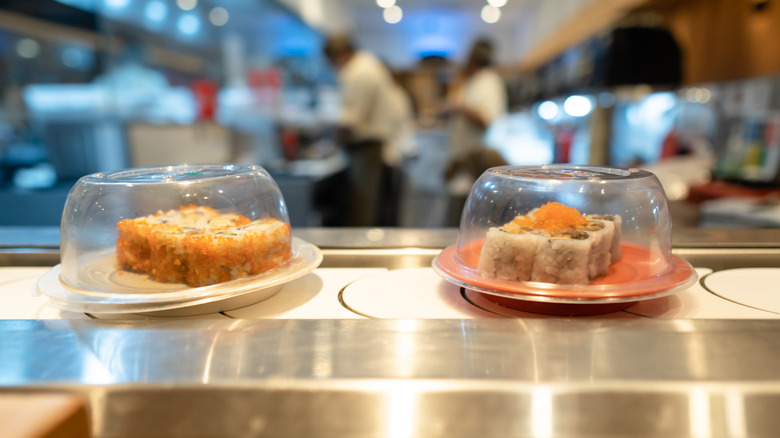How Asahi Beer May Have Inspired Conveyor Belt Sushi
It may seem that beer production and creating sushi have little in common. Still, a tour of the Asahi beer company inspired one restaurant owner to create the first kaitenzushi restaurant, also known as conveyor belt sushi. According to Japan Guide, the sushi served at a kaitenzushi tends to cost less than more traditional sushi restaurants, known as sushi-ya in Japan.
In a kaitenzushi or sushi train restaurant, colored plates of sushi travel around on a conveyor belt, allowing diners at tables or at a counter to select what they want to eat. A different price is associated with each plate color (via Japan Guide). Per Gurunavi, you can also order off of a menu, which is increasingly available on a screen or tablet, and choose from traditional nigiri (ball of rice with fish), temaki (handroll), and sashimi (pieces of raw fish without rice).
It's also an opportunity to try some inventive types of sushi, Gurunavi says. Because of the casual nature of a kaitenzushi restaurant, it's not uncommon to find sushi toppings like roast beef and mini hamburger patties on small rice beds. Typically, plates will have one or two pieces of nigiri or three to four pieces of a roll, according to Bokksu. Miso soup, desserts, and other options are also available for ordering. The bill for the sushi meal is tabulated based on the number of empty plates on the table.
The conveyor belt is useful for beer and sushi
Restauranteur Yoshiaki Shiraishi visited Asahi brewery and realized that the technology used in the plant could help in sushi restaurants, chronicles Kokoro Care Packages. He believed a conveyor belt could increase efficiency by transporting and feeding the rice-and-fish combo to customers while also reducing the number of staff.
According to Kokoro Care Packages, it took Shiraishi five years to develop his conveyor belt method, during which he was challenged with figuring out the right speed for the belt. If the belt moved too quickly, it would prove challenging to grab the plates. Conversely, diners may become impatient if the belt moved too slowly, making this invention futile. Eventually, in 1958, Shiraishi opened Mawaru Genroku Sushi, the original kaitenzushi, and it was a huge success (via Bokksu). In 1970, Mawaru Genroku Sushi gained fame when it was an exhibit at the Osaka World Expo, spurring competitors from all over the world to open their own.

